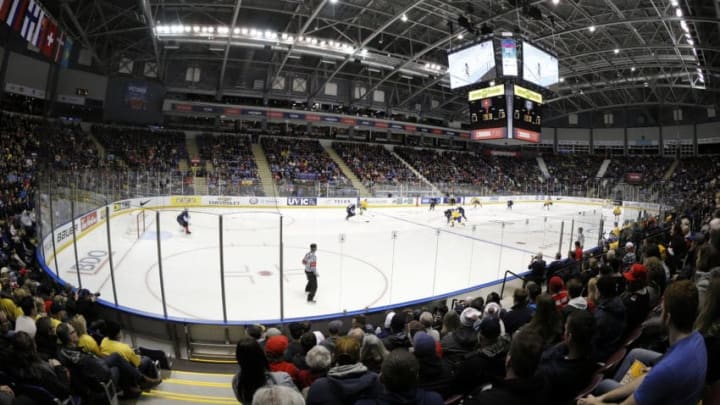
Positives and Negatives
First of all, I put a lot of stock in how good a player is with their skating abilities. I understand skating isn’t everything, and there are really good skaters whose game doesn’t translate to much success. But when a player is a very good skater, most things come easier with it. That’s why Wallinder, despite being bigger, is an excellent skater is important to me.
Wallinder has smooth, long strides, with an excellent first step. He has excellent edge work, as he’s able to complete sharp turns, as well as stop on a dime, depending on what’s needed. He also has strong balance, thanks in part to his size, which translates smoothly into lower-body strength.
In the offensive zone, Wallinder loves controlling the play from the point. One of the things he likes to do most from that spot is fire slap shots towards the net. He possesses power and accuracy on his slap shots as well, which makes him really dangerous. He keeps his shots low and on the net, which generates high danger chances like tips or rebounds.
His wrist shots are under-utilized and underrated, but it’s also a strong part of his game. If he were to fire more wrist shots than slap shots, I feel he could be more dangerous in the offensive zone. He has a quick release and sneaky good accuracy. His wrister also has a lot of steam on it. Though it’s not exactly NHL-ready yet, his shot is consistent enough to beat a goalie with regularity.
He isn’t a one-trick pony in the offensive zone either. Though he would rather let a shot loose, he also has solid passing abilities. For the most part, he keeps his game simple, never forcing passes that aren’t available. However, he consistently gets the puck where he wants it to go. He has decent vision, but he isn’t going to break open games from the blue line by hitting teammates on the doorstep with a tape-to-tape pass.
Overall, his offensive game isn’t flashy. As stated above, his means of attack is purely on his shot. He needs to work on his entire offensive game and put more importance on moving the puck around and balancing out how often he takes slap shots and wrist shots.
He has produced well throughout his career, albeit at low levels, but if he can improve and work out the kinks of his offensive game, then he projects well at the next level. However, it’ll take a lot of coaching and personal improvements to accomplish that.
Wallinder has excellent positional awareness in all three zones. He seemingly knows where to be and when. He also has great anticipation, which helps in his ability to get to where he needs to be. That’s a great sign, as it points towards high IQ, but he plays in lower-level leagues, and so the pace is a lot slower. I want to see him show the same abilities in a full Allsvenskan season, or in SHL play before I put too much into his anticipation.
Wallinder, despite being a bigger guy and seeming like more of a defensive-oriented player, is actually very good in transition. His ability to make stretch passes and the confidence to skate it up ice himself, and being good at it, is absolutely a positive sign. Again, I’d like to see that consistently displayed at a higher-level league.
Wallinder is strong in the defensive zone. He does an excellent job with his positioning. When the puck is on the opposite side of the zone, he parks himself in front of the net and battles with opponents to make sure his goalie isn’t screened.
When the puck is on his side, he does a nice job taking away the middle of the ice and getting in front of the opposing players shooting and passing lanes. He also doesn’t chase the puck or get sucked too far out of position, doing a nice job keeping himself in check and returning to his spot when needed.
When the opposing team is on the rush, Wallinder displays excellent gap control. He stays tight to the puck carrier, using his long stick to interfere with any moves to the inside. This allows him to force the opposing puck carrier to the outside, which allows him to close in and either hit that guy or swipe the puck away.
Hitting is an area that he loves, yet may not be his best trait. I’m all for more physical defensemen, but that’s a dying breed. In Wallinder’s case, he shouldn’t necessarily change that, as he is bigger and stronger than most guys.
But he needs to become more disciplined in a sense. He needs to better understand when he should step up and deliver a hit, and when he shouldn’t. He too often mistimes his steps, and players beat him to the outside, or he steps up and allows for a pass, which leads to an odd-man rush.
Overall, his defensive game is sound but still very much raw. Like in his offensive abilities, he possesses the right tools but needs to figure out which tools to use when it’s necessary to use it. Quite simply, he has a strong base of skills, but with an increased difficulty in opponents he faces, along with mental toughness and good coaching, he could become an excellent defender.
